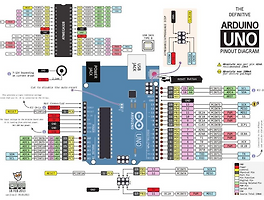하호~ 질린다. 5개 센서들을 모조리 테스트 하고 포스팅 하려니 힘이 쭉 빠지네. 마지막 센서.
3축 가속도 센서 MMA8452Q 센서다.
회로 연결은 아래 그림을 참고한다.
데이터북은 다음 링크를 참고한다.
MMA8452Q, 3-axis, 12-bit/8-bit digital accelerometer - https://www.nxp.com/docs/en/data-sheet/MMA8452Q.pdf
SparkFun Triple Axis Accelerometer Breakout - MMA8452Q Arduino Library 라이브러리는 아래 링크를 참고한다.
https://github.com/sparkfun/SparkFun_MMA8452Q_Arduino_Library
아래에 소스코드를 나타낸다. Sparkfun_MMA8452Q_Basic 파일 소스코드인데 안나온다. ㅠ.ㅠ
일단 센서 라이브러리는 아래 링크를 참고한다.
MMA8452Q is a tiny and low-power three-axis accelerometer
https://github.com/zamanandrew/MMA8452Q
압축파일을 풀면 폴더가 MMA8452Q-master 생긴다. 이 폴더 통채로 아두이노 프로그램이 설치된 폴더의 library 폴더 아래에 복사해 넣는다.
센서의 특징을 아래에 나타낸다.
FEATURES
- Normal and fast raw axes values reading
- Scale configuration (allowed 2g, 4g and 8g scales)
- Custom offset calibration
- Low noise mode
- Orientation detection (portrait/landscape and back/front)
- Auto-WAKE/SLEEP mode and detection
처음에 소스코드를 입력하면 동작을 잘 안한다. 그래서 MMA8452Q-master 폴더 아래의 MMA8452Q.cpp 파일을 열어보니 36 라인에 #define MMA8452Q_ADDRESS 0x1D 가 있다.
우리 회로는 MMA8452Q IC의 SA0 핀을 GND 로 묶어 놓았다. 그래서 주소는 1C 가 된다. 따라서 이 부분을 아래와 같이 수정해서 컴파일하고 실행하니 잘된다.
MMA8452Q-master 폴더 아래의 MMA8452Q.cpp 파일 36line 수정
#define MMA8452Q_ADDRESS 0x1C
소스코드를 아래에 나타낸다. 심플 코드
1 2 3 4 5 6 7 8 9 10 11 12 13 14 15 16 17 18 19 20 21 22 23 24 25 26 27 | #include <MMA8452Q.h> #include <Wire.h> /* so the Arduino IDE auto-detects the dependency */ MMA8452Q accel; int axes[3]; void setup() { Serial.begin(9600); if (accel.begin()) while (1); /* error */ } void loop() { /* get and print raw axes values */ accel.axes(axes); Serial.print("x: "); Serial.print(axes[0]); Serial.print(", y: "); Serial.print(axes[1]); Serial.print(", z: "); Serial.println(axes[2]); delay(1000); } | cs |
실행시키면 아래와 같은 아름다운 결과가 나오는데, 정확한 것은 다시 분석을 해야하니 가장 심플한 예제코드를 본다고 생각하고 한다.
x: 45, y: -2021, z: -88
x: 55, y: 55, z: 992
x: 50, y: 55, z: 1003
x: 54, y: 56, z: 994
x: 57, y: 58, z: 1000
x: 184, y: 122, z: 1035
x: -1013, y: 41, z: 196
x: -1020, y: -18, z: 125
x: -1031, y: -35, z: 137
x: 953, y: -123, z: 199
1 2 3 4 5 6 7 8 9 10 11 12 13 14 15 16 17 18 19 20 21 22 23 24 25 26 27 28 29 30 31 32 33 34 35 36 37 38 39 40 41 42 43 44 45 46 47 48 49 50 51 52 53 54 55 56 57 58 59 60 61 62 63 64 65 66 67 68 69 70 71 72 73 74 75 76 77 78 79 80 81 82 83 84 85 86 87 88 89 90 91 92 93 94 95 96 97 98 99 100 101 102 103 104 105 106 | #include <MMA8452Q.h> #include <Wire.h> /* so the Arduino IDE auto-detects the dependency */ MMA8452Q accel; int axes[3]; uint8_t orientation; void setup() { Serial.begin(9600); if (accel.begin()) while (1); /* error */ /* the board MUST be inactive during setup */ accel.active(false); /* set scale to 2g (default) */ accel.scale(2); /* disable fast read (default) */ accel.fastRead(false); /* enable orientation detection */ accel.detectOrientation(true); /* enable auto-sleep/wake mode */ /* accel.autoSleep(true); */ /* enable low noise mode */ /* accel.lowNoise(true); */ /* calibrate axes */ /* accel.offset(-10, -2, 0); */ /* enable the board */ accel.active(true); } void loop() { /* check board current mode */ switch (accel.sysmod()) { case MMA8452Q::STANDBY: Serial.println("StandBy"); break; case MMA8452Q::SLEEP: Serial.println("Sleep"); break; case MMA8452Q::WAKE: Serial.println("Wake"); break; } /* get and print raw axes values */ accel.axes(axes); Serial.print("x: "); Serial.print(axes[0]); Serial.print(", y: "); Serial.print(axes[1]); Serial.print(", z: "); Serial.println(axes[2]); /* get orientation status and check if it changed from last read */ if (accel.orientation(&orientation)) { /* get and print portrait orientation status */ switch (accel.portrait(orientation)) { case HIGH: Serial.println("Portrait Up"); break; case LOW: Serial.println("Portrait Down"); break; default: Serial.println("No Portrait"); break; } /* get and print landscape orientation status */ switch (accel.landscape(orientation)) { case HIGH: Serial.println("Landscape Right"); break; case LOW: Serial.println("Landscape Left"); break; default: Serial.println("No Landscape"); break; } /* get and print back/front orientation status */ if (accel.backFront(orientation)) Serial.println("Back"); else Serial.println("Front"); } delay(1000); } | cs |
컴파일 업로드 하면 아래와 같은 아름다운 결과 화면을 씨리얼 포트를 통하여 볼 수 있다.
Wake
x: 57, y: 44, z: 1006
Portrait Up
No Landscape
Front
Wake
x: 61, y: 50, z: 1000
Wake
x: 61, y: 53, z: 1000
Wake
x: 57, y: 54, z: 992
Wake
x: 58, y: 53, z: 986
Wake
x: 84, y: -250, z: 901
Wake
x: 50, y: -688, z: 702
Portrait Up
No Landscape
Front
Wake
x: 37, y: -715, z: 650
'개발자 > Arduino' 카테고리의 다른 글
| 아두이노 먼지센서 PM2005, PM2007, PM2008M 예제코드 (0) | 2018.11.23 |
|---|---|
| 레이저 미세먼지 센서 PM2008M 을 아두이노메가 측정 코드와 결과 (2) | 2018.11.22 |
| 아두이노로 만든 반응하는 인형 9가지 구성품 테스트 코드 (0) | 2018.06.22 |
| 아두이노 라이브러리 리스트 Arduino Library List 1470개의 라이브러리 모아놓은 곳 (0) | 2018.04.24 |
| 조도 빛 센서 TMD27723 센서 - ambient light sensing (ALS) (0) | 2018.04.19 |
| bmp180 디지털 압력센서 아두이노 라이브러리 테스트 (0) | 2018.04.19 |
| 온도 습도센서 HTU20D, HTU21D 아두이노 라이브러리 코드 (0) | 2018.04.19 |
| MS5637 Barometric Pressure Sensor 아두이노 라이브러리와 코드 (0) | 2018.04.19 |
취업, 창업의 막막함, 외주 관리, 제품 부재!
당신의 고민은 무엇입니까? 현실과 동떨어진 교육, 실패만 반복하는 외주 계약,
아이디어는 있지만 구현할 기술이 없는 막막함.
우리는 알고 있습니다. 문제의 원인은 '명확한 학습, 실전 경험과 신뢰할 수 있는 기술력의 부재'에서 시작됩니다.
이제 고민을 멈추고, 캐어랩을 만나세요!
코딩(펌웨어), 전자부품과 디지털 회로설계, PCB 설계 제작, 고객(시장/수출) 발굴과 마케팅 전략으로 당신을 지원합니다.
제품 설계의 고수는 성공이 만든 게 아니라 실패가 만듭니다. 아이디어를 양산 가능한 제품으로!
귀사의 제품을 만드세요. 교육과 개발 실적으로 신뢰할 수 있는 파트너를 확보하세요.
캐어랩







